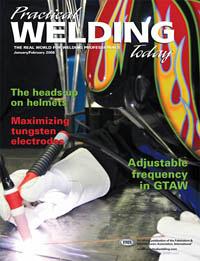- FMA
- The Fabricator
- FABTECH
- Canadian Metalworking
Categories
- Additive Manufacturing
- Aluminum Welding
- Arc Welding
- Assembly and Joining
- Automation and Robotics
- Bending and Forming
- Consumables
- Cutting and Weld Prep
- Electric Vehicles
- En Español
- Finishing
- Hydroforming
- Laser Cutting
- Laser Welding
- Machining
- Manufacturing Software
- Materials Handling
- Metals/Materials
- Oxyfuel Cutting
- Plasma Cutting
- Power Tools
- Punching and Other Holemaking
- Roll Forming
- Safety
- Sawing
- Shearing
- Shop Management
- Testing and Measuring
- Tube and Pipe Fabrication
- Tube and Pipe Production
- Waterjet Cutting
Industry Directory
Webcasts
Podcasts
FAB 40
Advertise
Subscribe
Account Login
Search
Stainless Steel Workshop: Duplex stainless and its alloys
- By Jeff Heagey
- January 15, 2008
- Article
- Metals/Materials
What is duplex stainless steel?
Duplex stainless is fast becoming the material of choice when improved corrosion resistance and mechanical properties are required. Through the combined efforts of the steel producers and the filler metal manufacturers, the market is better equipped to use these alloys for general fabrication. Whether your need is for GTAW, SMAW, GMAW, FCAW, or SAW, there is a duplex alloy for your application.
As the name implies, duplex means two. The microstructures of duplex steels consist of both ferrite and austenite to form a ferritic-austenitic structure. This Cr-Ni-Mo-N composition produces good strength and toughness, resistance to pitting corrosion, and an excellent resistance to stress-corrosion cracking. These unique properties make these alloys like no other stainless steel grades.
Duplex stainless steel comes in various grades, including a base metal grade known as 2205 (22 percent Cr, 5 percent Ni, 3 percent Mo, and 0.15 percent N), sometimes referred to as UNS S32205. This alloy is welded with a 2209 filler metal. Super- duplex grades are available too. One such grade is the base metal 2507 (25 percent Cr, 7 percent Ni, 4 percent Mo, and 0.25 percent N), commonly referred to as UNS S32750. This alloy is welded with a 2509 filler metal. Other variations of superduplex stainless containing copper and tungsten are available commercially that provide better mechanical properties. Two such grades are UNS S32550 and UNS S32760, better known as Ferralium® 255 and Zeron® 100. These grades also can be welded with 2509 filler metal, provided that no sulfuric acid is present in the service.
About the Author
Jeff Heagey
ESAB Welding & Cutting Products
717-630-3445
About the Publication
subscribe now

The Welder, formerly known as Practical Welding Today, is a showcase of the real people who make the products we use and work with every day. This magazine has served the welding community in North America well for more than 20 years.
start your free subscription- Stay connected from anywhere

Easily access valuable industry resources now with full access to the digital edition of The Fabricator.

Easily access valuable industry resources now with full access to the digital edition of The Welder.

Easily access valuable industry resources now with full access to the digital edition of The Tube and Pipe Journal.
- Podcasting
- Podcast:
- The Fabricator Podcast
- Published:
- 04/16/2024
- Running Time:
- 63:29
In this episode of The Fabricator Podcast, Caleb Chamberlain, co-founder and CEO of OSH Cut, discusses his company’s...
- Trending Articles
Sheffield Forgemasters makes global leap in welding technology

Welding student from Utah to represent the U.S. at WorldSkills 2024

Lincoln Electric announces executive appointments

Engine-driven welding machines include integrated air compressors

ESAB unveils Texas facility renovation

- Industry Events
16th Annual Safety Conference
- April 30 - May 1, 2024
- Elgin,
Pipe and Tube Conference
- May 21 - 22, 2024
- Omaha, NE
World-Class Roll Forming Workshop
- June 5 - 6, 2024
- Louisville, KY
Advanced Laser Application Workshop
- June 25 - 27, 2024
- Novi, MI



























